As an Amazon Associate I earn from qualifying purchases.
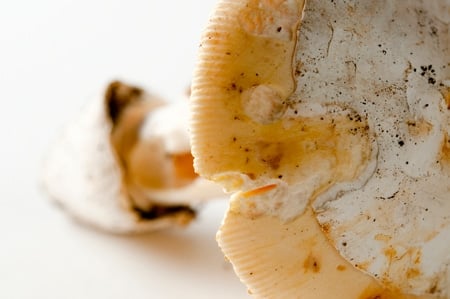
Hundreds of edible wild mushrooms exist in North America, and many, like the beloved morel, are so easy to identify a mildy clever chimp can spot them with no trouble. The coccora is not one of those mushrooms.
Welcome to the wild and woolly world of Amanita vernicoccora. Never heard of it? Not surprising, as it is also known as A. calyptrata, A. lanei and A. calyptroderma. It has a beautiful little cousin named Amanita velosa, too — although that one is in it’s own group, biologically speaking. The Italians call the entire group either coccora or coccoli, and they are one of the finest-eating mushrooms in the world.
But, as you may have divined, they are also in the genus Amanita, which happens to include some of the deadliest mushrooms in the world. Therein lies the conundrum. Amanitas are not to be trifled with, especially here on the West Coast. We are home to the death cap, A. phalloides, the destroying angel, A. ocreata, as well as a rogue’s gallery of lesser nasties.
A whole other group of amanitas, led by the magnificent A. muscaria, which I have eaten, may not kill you, but will mess with your insides and your brain. Flying reindeer, anyone?
So why play with this genus at all? Some very good mushroomers, notably Michael Kuo, simply won’t. They subscribe to the “amanita no-eat-ah” rule. I find this silly. It’s like refusing to eat tomatoes because they are cousins of deadly nightshade. Nor do I take the eating of amanitas lightly, however. I have spent the time to learn about these mushrooms for one primary reason: They are over-the-top wonderful at the table.
I will take a coccora (A. calyptroderma, remember?) over most mushrooms any day of the week. I like them better than — gasp! — morels, any of the Agaricus clan (this includes the button and portobello mushrooms you buy in the store), and quite possibly even the mighty porcini. They are that good. And A. velosa, the springtime amanita, is better still.
Before you head out into your woods eagerly seeking this treasure, I need to stop you. If you are not an experienced mushroom hunter, and if you are not a generally cautious person, don’t mess with this mushroom. It can indeed be mistaken for one of the deadly amanitas by the unwary. Your liver is not worth a plate of mushrooms.
Let me repeat: If you are careless, you could die. I mean it.
Got it? Good. OK. Now, all warnings aside, you can safely identify a coccora if the mushroom you are looking at meets ALL of the following criteria.
Let’s start with habitat. Fall coccora like oaks and madrone in California, Douglas fir in northern Washington and Canada. Spring coccora prefer conifers; I’ve found them beneath cedar, fir and pine. For the rest of the country, keep in mind that this is primarily a Western mushroom, although there is a member of this family in the East, I have no experience with it. Coccora are mycorrhizal, which means they live in a symbiotic relationship with the trees they hang out with. That also means they’ll show up in the same spot every year.
There are two variants of coccora: Fall and spring, which is now officially A. vernicoccora. Fall coccora are easier to identify, as their caps are a warm, inviting orangey-tan. Both variants like to be around boletes, just like their cousin A. muscaria. And the fall variety really digs madrone trees. The spring version, which is what I am finding right now, prefers oaks in the Valley and conifers in the Sierra. It has a canary yellow cap.
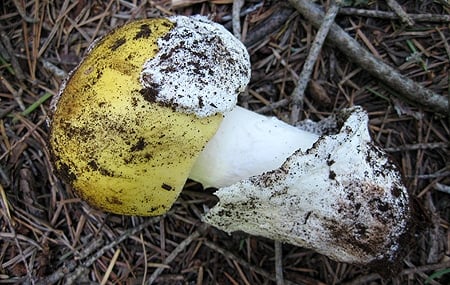
Keep in mind that color is never a good thing on which to hang your hat — or your liver and kidneys. One of the primary cautions about this mushroom, especially the spring version, is that its pale yellow cap can be confused with the greenish-yellow cap of the death cap. Both can be present at the same time, although I’ve found that the destroying angel, which is pure white, is a more common neighbor. Any all-white amanita should be avoided.
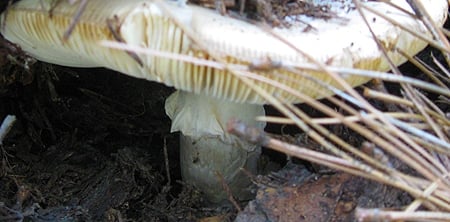
Look at the stalk of the mushroom above. Notice something? A floppy ring, or annulus. Young coccora have a sort of skirt around the stalk, but in weather or age this gossamer tissue can slough off. Lethal amanitas tend to have a more distinct annulus. The stalk should be a creamy white, not pale, bluish-white. But again, a death cap can have a creamy stalk, too. See how hard this can get?
Another thing to look for is the size of A. vernicoccora. It’s big. I picked one mushroom this week that weighed almost a full pound and was nearly 10 inches across at the cap. This size is another notch in the mushroomer’s favor: Lethal amanitas are not usually this large. Note that I say “not usually.” NEVER rely on one or even two indicators before eating any mushroom, and especially an amanita.
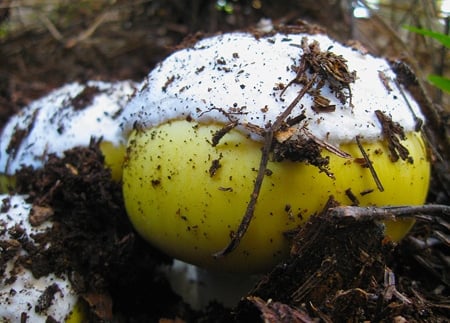
Now look at the cap. See the “skullcap” covering the yellow? That is another indicator of a coccora. In general, the “good” amanitas have this solid skullcap on top; it is the remains of the universal veil that covers the baby amanita. When the mushroom grows, it pushes up through this veil and the remains stick on the cap. In many amanitas this veil breaks into the characteristic “warts” so famous on Amanita muscaria — these are the white polka dots on muscaria’s red cap.
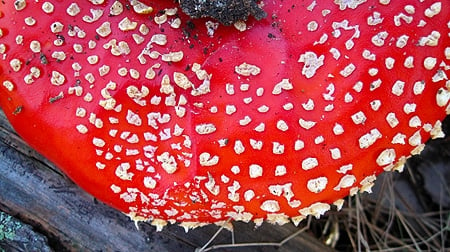
OK, now I’m going to mess with you again. Sometimes, the deadly amanitas also have this skullcap, and, conversely, I’ve found edible amanitas with the warts. In fact I found an A. velosa last week with warts. But the presence of a skullcap is a good sign. Another indicator is whether you can easily peel off the skullcap: You should be able to with a coccora.
Keep looking at the cap. Now look at its edges. Are they striated, like this?
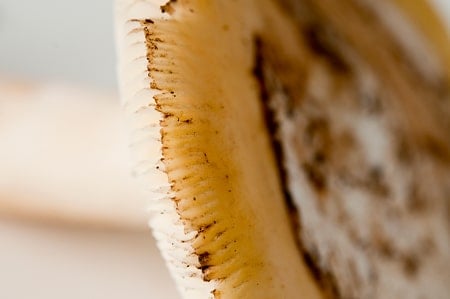
Here’s where we start getting into the nitty gritty of identification. All coccora, A. velosa and A. vaginata (grissettes, which I will get into in another post) have this striated cap margin. It is a very important identifier. Look for it especially on young specimens. If you only see it on old ones, beware: Poisonous amanitas can develop what look like these striations as they age. It’s because the cap is collapsing over the gills. See how the gills and striations match up? The mushroom above is a fresh coccora and these striations are the real deal.
The last indicator to see whether your amanita is edible or not comes when you slice the stem.
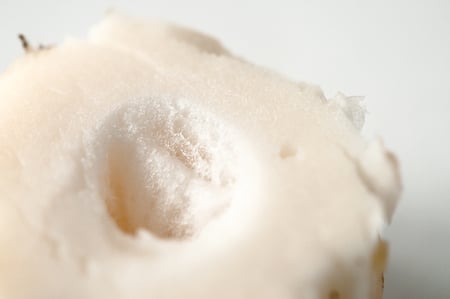
Coccora, A. velosa and grissettes all have hollow stems that often are partially filled with a cottony, webby material or a jelly-like substance. But here’s another warning: Some death caps or destroying angels also have this feature.
To review, you want your mushroom to fit every one of these characteristics:
- It has a substantial, thick and v-shaped “cup” at its base. All amanitas have cups, but the shape of the cup is an important “tell” as to which species it is.
- The cap is buffy orange-tan, salmon-colored (fall), or canary or lemon yellow (spring), and definitely NOT white or greenish.
- The center of the cap has a skullcap, not warts. This skullcap should be easy to peel off.
- The edge of the cap has distinct striations, even on very young specimens.
- The stalk does not have a thick annulus or ring around it, although a coccora often will have a wispy, skirt-like ring on the stalk when young. Many times this gossamer annulus sticks to the underside of the gills.
- When you peel the v-shaped “cup” off the bottom of the stalk, the base of the stalk is not bulbous; it should be more or less the same width throughout, or with a slight taper.
- The stalk is hollow, and often partially filled with a cottony, weblike substance and/or a clear jelly.
If your mushroom does not meet every one of these requirements, toss it. It might still be an edible variety, but it is unsafe even for experienced mushroom hunters to eat amanitas that are not “true to type.”
One more thing: Just because you’ve found some coccora, that does not mean the mushroom next to it is also a coccora. I’ve seen destroying angels grow right next to A. velosa. Identify each and every mushroom in your basket separately.
So by now you must be wondering why on earth would I bother with all this for a mushroom? Here’s why:
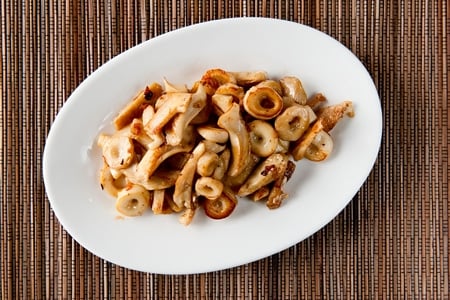
This is one of the better plates of mushrooms I have eaten. All I did was sear the coccora a little in a hot pan until they released their water, then added several tablespoons of butter and some Italian sea salt. I cooked them over medium-high heat until they got a little caramelized on the edges.
If you’re thinking they look like calamari rings, you’re right. Coccora have a delicate shellfish/calamari flavor that gets horrific when the mushroom ages — an old one stinks like rotten shrimp. But young and fresh they are firm, meaty, light in the sense that chicken feels “lighter” than beef, and have an amazing presence on the plate.
All foragers must make their own choices about what they will eat, what risks they are willing to take. All I can say is that if you choose to gather coccora, be cautious. Believe me, I gathered many of these mushrooms before I ate any, and even though I was absolutely certain of my identification, I still had a little flutter when I ate these. I probably always will.
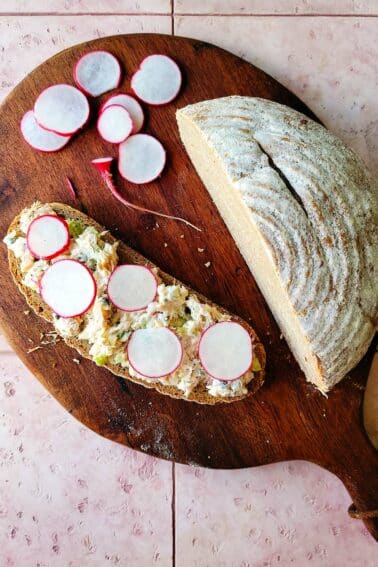
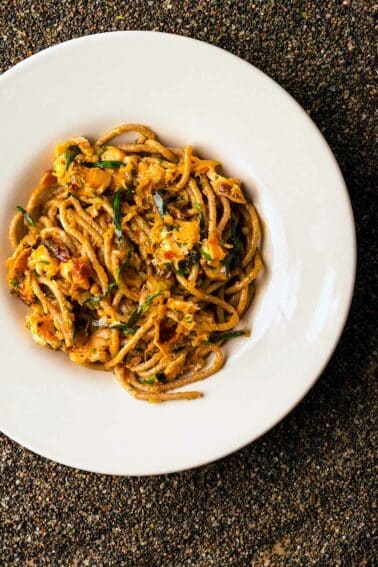
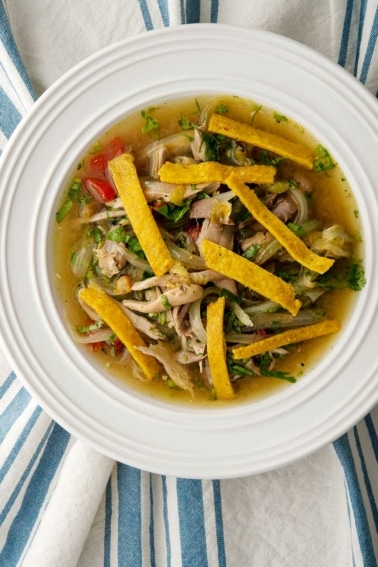
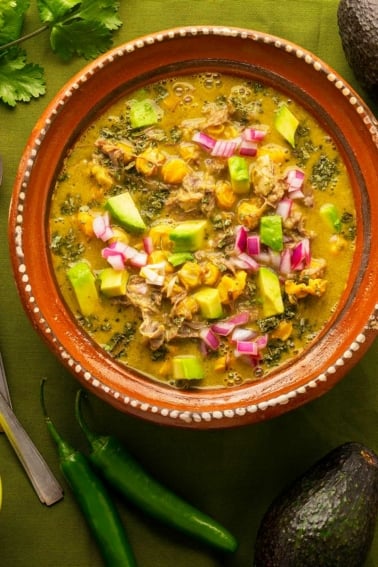
Perry: With all due respect, and this is not directed at you in particular, but I get pretty frustrated with mushroomers pretending that edible amanitas just don’t exist. They are in fact identifiable, and are far easier to key out than, say, a fresh candy cap. People who say I shouldn’t post about this mushroom are not helping to expand our knowledge about them. It almost smacks of censorship.
On the other hand, your observation that you’ve seen A. phalloides, pantherina and ocreata with pithy stems and striated caps does help the larger debate.
But I ask you this: Have you seen an ocreata or a phalloides that is canary yellow under the duff, not sun-bleached, with a pithy stem, a hat-like universal veil that comes off easily, a striated cap and that thick, v-shaped cup? Chances are you have not.
Identifying this mushroom is about matching all of these characteristics, which, when taken in total, make this mushroom quite safe. Danger lies in carelessness.
I’ve been hearing for years from hardcore Coccora hunters that they are “the best”. After four years of picking them and getting the ID confirmed I finally had the confidence this year to try them. I found a few prime coccora underneath some massive madrones in early November. I can’t say they were memorable, they had a good crunchy texture though. I was much more excited about the 40lbs of B. edulis we found. I don’t think I would pick Coccora again. I found several of the Spring Coccora this year as well, but not worth the risk to me. I am surprised that you posted about them considering how inexperienced you’ve come across in fairly recent posts in regards to mushrooms. I don’t mean this as a slight, it’s just unexpected.
I do think your key checklist is good, however I have found phalloides, pantherina, and ocreata with pithy stems and striated caps. I have also heard that amanita hybrids can occur (I believe this is with A. pantherina and A. calyptrata). I would honestly be more comfortable eating A. muscaria than the Coccora species complex. I realize that you have definitely not downplayed the risk, but I do agree with a few of the other commenters that it seems a little questionable to post about them.
Alan: Thanks for that. I’ve altered the post to reflect what you’ve observed. I too have seen it a couple times, but now with the mushroom community letting me know that what I saw was not a freak, I think this ID guide is even safer.
Regarding “Coccora, A. velosa and grissettes all have hollow stems that often are partially filled with a cottony, webby material or a jelly-like substance. Neither the death cap nor the destroying angels have this feature.”
This is often said, but isn’t really true. I found a lot of A. ocreata last week and cut them all open and found that fully half of them had hollow stems. They are slightly different – The deadly ones often had chambers in the hollow part, but not always. See https://mushroomobserver.org/92976 for my pics.
I eat Amanita velosa often and I do believe it is the most delicious wild mushroom. It is well worth peoples time to learn to ID it and separate it from A. ocreata. Often A. ocreata has a reddish tint in the middle of the cap that can make it look a bit like A. velosa.
I am a mushroom hunter in California, that eats Amanitas now and then. Just wanted to pass on a couple things.
1. All of the Amanitas I find, including the A. phalloides (death cap), A. Ocreata (Destroying Angel), and all the great edibles, typically have hollow/stuffed stems. I would not use this as a strong criteria for differentiating the different species.
2. It is not uncommon for me to find GIGANTIC A. ocreata fairly regularly, that are every bit as big and meaty as the coccora, and these at times include veil patches on the cap AND have yellow/brownish cap colors reminiscent of the edibles.
I don’t believe Amanitas should be completely avoided for the table. I think they include some fantastic ones that can be eaten safely (I’ve been happily eating lots of grissettes the past few weeks). BUT, nobody should be collecting and eating Amanitas before they have some experience collecting and ID’ing mushrooms in general. And absolutely, nobody should be collecting any amanita for the table until they have collected and studied a good number of the deadly poisonous members of the clad in various shapes sizes and colors.
BTW, just stumbled across your site. Very good stuff.
Hi Hank!
Excellent post. I’ve been working on getting to know my amanitas since I first started mushroom foraging 8 years ago. I just picked and ate my first amanita last week. I’ve been extremely cautious because I don’t want to make a deathly (and apparently painful) mistake. Back when I first started foraging, I searched for all kinds of advice on how to identify mushrooms that very few people knew about. It’s great that someone has taken the time to tell the story of the coccoras, mushrooms that are highly prized in places that know how to eat them. These were Amanita velosa and they were as superb as I could have expected from all the reviews I’d heard. I really think they might be the best I’ve ever had: meaty but with an almost crisp firmness, incredibly sweet, with a mild nutty flavor and umami rich. Like you mentioned, the mature ones smelled pretty ripe, but they were fine, superb really, fried up until they caramelized a bit in brown butter with little slivers of garlic.
Edible amanitas are like a unique treasure that rewards those who are 1) brave and 2) patient enough to take the time to learn the nuances of this gorgeous family of mushrooms. It’s awesome that someone’s taken the time to walk through some of the basic identifying features of edible amanitas in such detail. Hopefully people posting about their culinary Amanita experiences can help to build a culture around eating them, just like there is a culture of eating chantrelles, morels, boletes and other wild shrooms prized by the gourmet world. The Italians did it, why can’t we?
–Melissa S.
Ed: A lot of long-time mushroomers share your friend’s view. And he is entitled to his opinion, but there are plenty of equally experienced mushroomers who, like me, take this very seriously but still choose to eat certain amanitas. To each his own.
Hank,
I shared this post with a long-time mushroom forager I know. I can’t repeat his profane words here, but I’ll say that “irresponsible” sums it up. He related to me that Sam Sebastiani (of the wine family) died from eating a Amanita phalloides and that even experienced people die from eating Amanitas. His bottom line was “There are so many easy to distinguish mushrooms to be taken, why take even the most remote of chances that you can die by harvesting an Amanitas? I don’t care how good the mushroom might be, it is not worth the risk.”
You obviously don’t have a lawyer on retainer.
Great post, and good luck with it. This, by the way, is a sure sign you are walking the mycologists path. Pretty soon, you will start describing particular varieties as making good houses for all the tiny blue people you see after you eat them.
I’m a total wimp on the Amanita front. I see a little egg at the base of the stem, and i’m OUT. I even passed up some grisettes, even though I was rock solid on the I.D. I just couldn’t bring myself to pick em.
I bet they taste fantastic. Grass over there, that’s greener too, LOL.
Thanks for the extensive I.D. guide, appreciate it. Maybe someday I’ll get up the guts to use it.
Bp
Carter: Damn, that’s a big one!
Nicole: Next one I get I’ll have to try the light pickle. You are not the only one to suggest that.
Marcus: Yes, join a local mushroom club. It is important. A person can teach you SO much better than a book. Lots of nuances you can miss otherwise…
Thanks for posting such a detailed description. I have started working my way through Demystifying Mushrooms, but after looking at a book that size, they seem a little more mystifying. Thinking I should join a local mushroom club.
Yes, they are the very best of the amanitas. Love them lightly pickled in lemon juice. Add a good yellow winter olive oil and some sel Gris, even a sliver or 2 of green onions and a few mild olives. Rock your world.
Glad you see you scored, Hank. I went looking for straggler chanterelles and found a few, but not much quality.
I have found coccora to taste more vegetable-like than seafood-like. Kinda like a cross between carrots, green beans, and mushroom. I can’t say that they’re my favorite, but all of the ones I’ve ever eaten were collected in the Sierras and it could be that the different fruitings taste different and/or I need a lesson on how to cook them.
https://i578.photobucket.com/albums/ss229/MrCJMan/IMAG0069.jpg
Nicole: They had a slight annulus, like a skirt. They are not velosa, sadly. 😉 WAY too large and way too yellow. If you are seeing “hen egg brown” in these images, it is your computer. They are pale yellow — I even had to up the saturation a bit to make it evident on the computer screen.
Hi Hank,
Did these mushrooms have an annulus? I couldnt tell from the picture If not, then this mushroom looks more like a velosa then a coccora. The color looks more hen egg brown, too. The spring coccora are a pale yellow.
Just curious…..